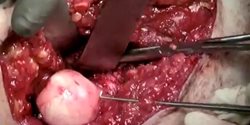Hip Injuries in Young Athletes are Rising: Can Genetics Aid Hip Preservation?

Hip injuries in young athletes are rising rapidly, and genetics may explain why only some who play a hip-punishing sport end up with femoroacetabular impingement (FAI) that progresses to hip osteoarthritis (OA). University of Rochester Medical Center Orthopaedic surgeon Brian Giordano, M.D., and researcher Chia-Lung Wu, PhD. are the first to investigate FAI and hip OA using stem cell technology, genome editing, single-cell RNA sequencing, and spatial transcriptomics.
How could this research help the athletes you treat?

Giordano: I’m an Orthopaedic surgeon with a multidisciplinary hip preservation program. In my practice, I see many young athletes who have hip issues such as FAI requiring surgery, as early as their teen years. Some of the damage is linked to overuse from sports such as soccer and hockey, but there’s also a genetic component for some people. Some of these patients with FAI will develop hip OA in 5 to 10 years. And some with similar joint shape and sport selection may never develop OA. In our pursuit to help patients and athletes preserve their native hip as long as possible, it is critical that we identify factors related to the progression of OA. In the last 5 years, our efforts have focused on finding ways to understand the genetic factors that regulate FAI’s influence on hip OA. In doing so, we hope to improve the health and quality of life of millions of young athletes.
How are you conducting this research? What tools are you using?

Wu: With our strong collaboration with Dr. Giordano, we’re able to harvest cartilage cells (i.e. chondrocytes) from patients with FAI and hip OA, respectively, by following IRB-approved protocol. These FAI and hip OA cartilage cells can be analyzed by single-cell RNA sequencing and spatial transcriptomics as well as bioinformatic analysis. Single-cell RNA sequencing allows us to observe the gene expression profile of these cells at a single-cell resolution, while spatial transcriptomics provides us information regarding spatial location of these cells within the cartilage tissue. With these tools, we can investigate cell-to-cell crosstalk – to observe which chondrocyte is “talking” to which chondrocyte and to predict whether their interactions (cell-cell signaling) may lead to hip cartilage degeneration. The predicted protein targets in cell-cell signaling will be further validated to understand their functional role in hip OA by using stem cells such as human induced pluripotent cells and CRISPR Cas9 gene editing tools.
How will this help us learn more about the factors that cause and exacerbate FAI?
Wu: Cartilage cells are heterogeneous in our knee, hip, or other joint cartilage tissues. Also, there are a lot of different cell types in joints, which can contribute to the problem: Is the joint degeneration caused by the cells in the cartilage, synovium, bone, tendon, or a combination? Additionally, the cell-cell interactions could be different for each patient, even for those who have the same symptoms of hip pain. We’re embarking on precision medicine, and these emerging technologies are enabling us to observe at the single-cell level to better understand how those cells function individually and as part of a patient’s anatomy.
Giordano: There is so much we don’t know about the factors that cause and exacerbate osteoarthritis. FAI has emerged as one identifiable clinical condition that has been linked to early onset osteoarthritis in young athletic populations. Being able to look at this condition cell by cell will show how unique anatomic features influence cellular signaling pathways within the joint. These biochemical pathways regulate the health or deterioration of cells within bone or cartilage. Understanding these pathways offers potential to intervene clinically or surgically to positively impact changes in the health of the joint over time and potentially prevent or delay the degradation of the joint. An individualized treatment plan could then be customized to each patient depending on their unique genetic susceptibility to joint degeneration. The single-cell study of disease could be applied to other conditions beyond Orthopaedics, including cancer and cardiology.
What have you found so far, and what’s next?
Wu: Our preliminary data shows that the Fibroblast Growth Factor 18 (FGF18) may be an important component involved in FAI and hip OA progression. We took samples from healthy patients and those with FAI and hip OA. FGF18 was present at the highest level in the healthiest patients, lower in samples taken from patients with FAI, and lowest in patients with hip OA. It is an interesting finding and further research can tell us whether treating patients with FGF18 could delay hip OA progression from FAI. Giordano: FGF18 could be injected into the patient several ways, including using nanoparticles for more precise delivery. In our upcoming research, we will harvest cells from patients with FAI and hip OA, treat them with FGF18 and assess the results. Our team has recently been awarded funding from the Orthopaedic Research and Education Foundation to explore this possibility. After these in vitro studies we’ll apply what we’ve learned to mouse models, with the intent to follow up with research involving human subjects.

Above, from left to right, images show the progression of osteoarthritis changes in the hip.
These are postulated to be induced by altered joint shape and anatomic conflict in the conditions of symptomatic FAI.
What have you found so far, and what’s next?
Wu: Our preliminary data shows that the Fibroblast Growth Factor 18 (FGF18) may be an important component involved in FAI and hip OA progression. We took samples from healthy patients and those with FAI and hip OA. FGF18 was present at the highest level in the healthiest patients, lower in samples taken from patients with FAI, and lowest in patients with hip OA. It is an interesting finding and further research can tell us whether treating patients with FGF18 could delay hip OA progression from FAI.
Giordano: FGF18 could be injected into the patient several ways, including using nanoparticles for more precise delivery. In our upcoming research, we will harvest cells from patients with FAI and hip OA, treat them with FGF18 and assess the results. Our team has recently been awarded funding from the Orthopaedic Research and Education Foundation to explore this possibility. After these in vitro studies we’ll apply what we’ve learned to mouse models, with the intent to follow up with research involving human subjects.